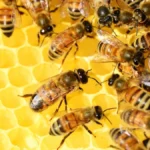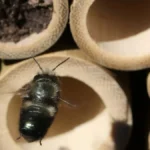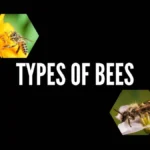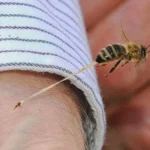Black bees are a common term for a type of carpenter bee. Carpenter bees are wood nesting bees, gentle souls, and exceptional pollinators. Are black bees poisonous? Not really. Read further to find out how you can live with these lovely bees, avoid problems and save damage to your buildings.
Clearing Up What A Black Bee Is
Within the honeybee family, there are bees from the British Isles and New Zealand that are called British Black bees – Apis mellifera mellifera. People also refer to certain types of carpenter bees that are black, or nearly black, as “Black Bees”. This article deals with the carpenter bee variety of black bees.
And quickly – with regards to the title “Are black bees poisonous?” they can sting you yes if you really provoke them. The sting is a non-event and hardly hurts at all in my experience.
What Are Carpenter Bees?
I have always loved carpenter bees. These bees have a lot of character – and they work hard, drilling holes in wood and nesting there. The Xylocopa genus comprises the carpenter bees – this is derived from the Greek word for “woodcutter”. These bees are in general excellent woodcutters! There are more than 500 species within the genus, and probably many we do not know of yet. As with so many bees, we probably discover new species as fast as human expansion makes others go extinct. Which is rather sad.
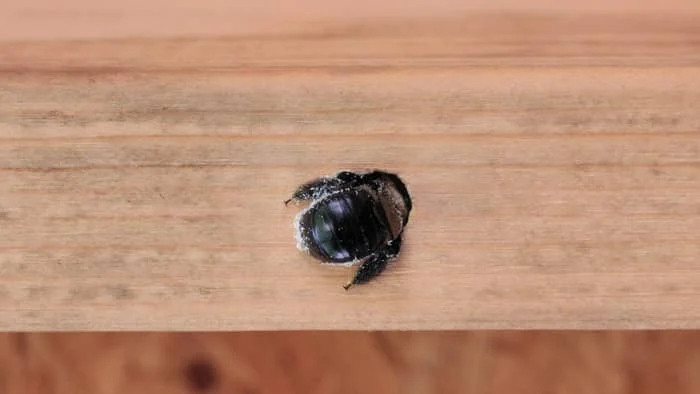
Read more about: Identifying A Bees Nest
How Do Carpenter Bees Do What They Do?
Carpenter bees are almost solitary bees (sometimes they can nest together in clusters) – they sometimes get confused with bumblebees as there are size and shape similarities. They start the season by emerging from the nest hole their mother made. Normally drones emerge first, followed by a handful of females.
Carpenter Bee Drones
Carpenter bee drones are absolute clowns – they will spend a lot of time being “tough guys” buzzing other drones. They are big strong boys and their job is to find a queen, persuade her they have the right stuff, and then mate with her. After this, they die. The drone grabs the queen and literally carries her through the air while mating. This is normally a loud buzzy affair, following which he just spirals to the ground. Drones will go to flowers to try and get nectar to keep alive while they look for ladyfriends and their inevitable demise.
Carpenter Bee Females/Queens
I love these ladies. They buzz around on flowers like giant fuzzballs. We have a few species where I live and one is absolutely huge. When a female lands on the flower it is like a huge helicopter landing and just blows pollen everywhere. Every year if I am growing fava beans I only get beans forming after the carpenter bees emerge in spring. Before that, honeybees can prance around on the flowers as much as they like but they just cannot pollinate fava beans.
Carpenter bee females generally place their mandibles against the material they wish to cut into and vibrate. This allows them to tear the material up fiber by fiber. The softer the wood, the easier it is for them, and the more they will nest. I have found that the easiest way to encourage carpenter bees is with pieces of bamboo. More on that later.
Are Carpenter Bees Good Pollinators?
I would probably go so far as to say they are in many cases the best pollinators. When it comes to a strawberry, raspberry (and similar berries), quince, apple, or plum flower, the carpenter bees seem to do a way better job than any other bee. Carpenter bees also appear to excel at complicated flowers such as fava bean and pea flowers. These flowers require a bit of strength to pollinate properly, and big carpenter bees just get in there and do the job. In this regard, for any gardener, providing a nesting site for carpenter bees is a crucial part of ensuring that you achieve maximum production out of a small garden.
Some species of carpenter bees are really big. This means they have a better surface area to volume ratio than smaller bees. Carpenter bees, like most bees and wasps, generate heat with their flight muscles. A honeybee has a small thorax – this means that there is a lot of surface area, and not much volume of muscle – hence they are limited to flying at temperatures above about 55°F. Carpenter bees seem to be able to fly at slightly lower temperatures. I have a tree in my garden where they nest – it gets early spring sunshine, and the bees will often start flying when temperatures are below 50°F. Because they are big bees, on a cool sunny day they seem to be able to function quite well.
This hollow tree in my garden is an excellent nesting site for Xylocopa species. The carpenter bees get early morning sunlight in summer, and in spring the tree has no leaves and they get day-round sunlight. They are excellent pollinators of my fava beans.
Weird Observations About Carpenter Bees
I once saw the most bizarre thing with a carpenter bee in early spring. She was working hard on some legume flowers. She was completely covered in pollen when a honeybee would then go and jump on her back. This triggered her to just fly out into a spot and hover while the honeybee cleaned all the pollen off her body and flew away. We saw this happening on multiple carpenter bees, and it was a bit sad actually watching these big bees working hard and then being robbed by the devious honeybees.
Can Carpenter Bees Damage My Building?
If they do not have an optimal nesting site, they may start burrowing into damaged wood in your building. Most modern structural timber is pretty hard and treated to prevent fungal degradation. If the wood gets a bit wet and fungi do take hold, it becomes soft and carpenter bees can burrow into it. If you see carpenter bees burrowing in your building they are generally a good warning that your timber has fungal issues.
I have helped hundreds of people deal with carpenter bee problems over the years. The best way is to just put nesting sites out that are in better places. I find two nesting sites work well – bamboo placed on a shelf, and an old piece of soft semi rotting wood placed somewhere. With time woodpeckers (and in my area Barbets) always come and pull these pieces of wood apart and if you are lucky they will nest there too. The above link shows a log my father Dr. Jim Cambray placed in a tree in their garden in 2007. Carpenter bees excavated a hole, and later woodpeckers and barbets enlarged the hole and nested.
You can purchase a carpenter bees nest that looks like this. Excuse the fact that the wombats in the company that makes that thing put honeybees all over it with photoshop. They clearly don’t know what they are doing, but the actual nesting site is perfect, so please overlook that issue.

Place the nesting site near where the carpenter bees are causing trouble. You can then break a few mothballs up. Slide them into the holes in your building where the bees are nesting, and this will drive the queens to the new nesting site. It takes about a year to do this. In fall once they are all done setting up the nest, move the new nesting site away, and fix your roof. Generally, a few coats of paint will keep the bees away from new timber.
What Is A Carpenter Bee Sting Like?
Are black bees poisonous? All stings are slightly poisonous. Black bee stings are the most underwhelming stings out there. They really just hardly hurt. If a bee sting is a bottle of vodka, a carpenter bee sting is Sting 0% – alcohol-free beer, or bottled water.
Quite a non-event. If somebody comes and says “I got a carpenter bee sting and it really hurt” just stare at them blankly. A carpenter bee sting is nothing to be scared of, and if you did get stung by a carpenter bee, we need to ask you why this happened? These bees do not like to sting. So if you got stung by a carpenter bee it is time to ask some deep questions about your own behavior and forgive the bee!! ( I have been stung by them a few times, and this was because I was being a complete idiot).
Do Carpenter Bee Drones Like Pretty Ladies?
Carpenter bee drones will sometimes bomb human females – something about the female hormones, hair scent and probably the perfume gets these boys excited and they can try and mate with you. Take it as a compliment – they think you are a beautiful queen and are willing to die for you (literally).
Don’t worry – they cant mate with you, and they also don’t have stings. Laugh them off just as you would do for any other overly enthusiastic guy that tries to hit on you.
I hope this has inspired you to go out and get nesting sites for these great bees. Are black bees poisonous? Now we know they are nearly not of any danger to you. They will bring great joy to you, productivity to your garden, and entertainment to your flower beds. Watching the drones clowning around in spring is just hilarious! If you enjoyed this please share.
Read more about: Types Of Bees
FAQs
What are black bees?
- Answer: Black bees often refer to Carpenter bees, a species known for their predominantly black, shiny bodies. These bees are large, resembling bumblebees, but with distinct differences in their appearance and behavior. Carpenter bees are common in many regions and are often found around wooden structures.
Are black bees, like Carpenter bees, poisonous?
- Answer: Carpenter bees are not poisonous. While they do have the ability to sting, female Carpenter bees are typically non-aggressive and rarely sting unless provoked. The male Carpenter bees, which are often more visible, do not have stingers and are completely harmless.
Do Carpenter bees sting?
- Answer: Yes, female Carpenter bees can sting, but they are generally not aggressive and only sting when directly threatened. Male Carpenter bees, despite their often territorial behavior, do not have stingers and pose no risk of stinging.
Are Carpenter bee stings dangerous?
- Answer: Carpenter bee stings are not considered dangerous to most people. The sting of a Carpenter bee is similar to that of a honeybee, causing mild pain and temporary discomfort. However, individuals who are allergic to bee stings should take precautions, as any bee sting could trigger an allergic reaction.
Why are Carpenter bees called black bees?
- Answer: Carpenter bees are often referred to as black bees because of their dark, shiny appearance. The species Xylocopa, which includes many Carpenter bees, has a predominantly black body, distinguishing them from other bee species like honeybees or bumblebees.
How can I tell the difference between Carpenter bees and other black bees?
- Answer: Carpenter bees are larger than most other black bees and have smooth, shiny abdomens, unlike the hairy abdomens of bumblebees. Carpenter bees are also solitary and are often seen hovering near wooden structures, where they bore holes to create nests.
Do black bees, such as Carpenter bees, pose a threat to my home?
- Answer: While Carpenter bees are not dangerous to humans, they can pose a threat to wooden structures. Female Carpenter bees bore into wood to create nesting galleries, which can cause structural damage over time if left unchecked. Protecting exposed wood surfaces can help prevent Carpenter bee infestations.
How can I prevent Carpenter bees from nesting around my home?
- Answer: To prevent Carpenter bees from nesting, it’s important to protect wooden surfaces with paint or varnish, as they prefer untreated wood. Plugging existing holes and using traps can also deter Carpenter bees from returning to nest in the same area.
What should I do if I find Carpenter bees around my property?
- Answer: If you find Carpenter bees around your property, consider monitoring their activity to assess any potential damage. For significant infestations, you may need to consult a pest control professional. However, if the bees are not causing damage, they can be beneficial pollinators and may not require removal

Dr. Garth A. Cambray is a Canadian/South African entrepreneur and beekeeper with 28 years of experience in apiculture and specializes in adding value to honey. His Ph.D. research developed a new advanced continuous fermentation method for making mead that has resulted in a number of companies globally being able to access markets for mead. His company, Makana Meadery, exports honey mead to the USA where it is available to discerning connoisseurs. He has also developed technologies to commercially manufacture organic honey vinegar in Zambia for export globally. He holds a few patents globally in the ethanol industry and believes in technology and knowledge transfer for human development and environmental sustainability. One of his proudest achievements is the fact that the wind farm he started at one of his old apiary sites has essentially made his hometown carbon neutral.

